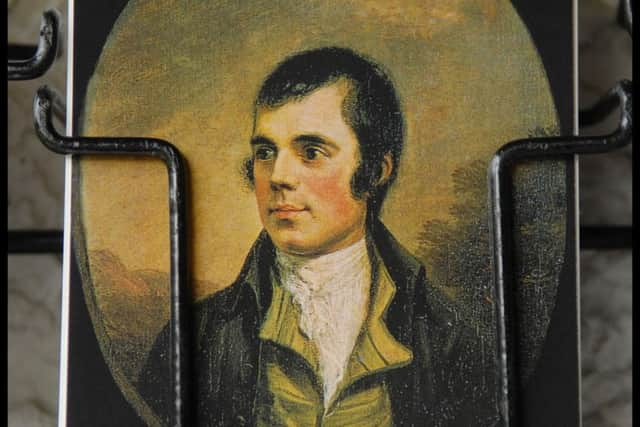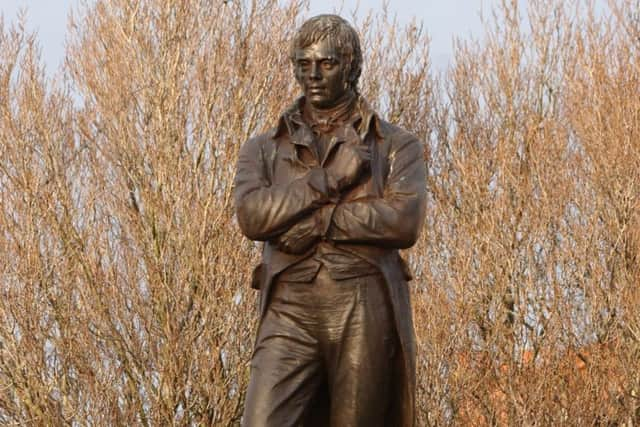From songs to stamps: Robert Burns references in popular culture
Burns wrote his first poem aged 15. By the time of his death in 1796, aged just 37, he had completed around 220 pieces of poetry. They have in turn inspired countless further works by other artists in thrall to the Bard of Ayrshire.
An ubiquitous presence
With more than 60 examples dedicated to the Scots poet, Robert Burns is third in line after Christopher Columbus and Queen Victoria in the number of statues dedicated to a non-religious figure worldwide. They can be found everywhere from Leith to Milwaukee.


Advertisement
Hide AdSouth of the border, Burns can be found seated in London’s Victoria Embankment Gardens, while a bust of him is also seen in the Poets’ Corner of Westminster Abbey. Northern Ireland has one statue of the man erected in Belfast, but the largest number of Burns statues anywhere in the world outside of Scotland can be found even further west in the United States of America.
While busts and statues can be found all the way from Vermont in the north to Texas in the south, there’s a particularly unique tribute erected in Atlanta, Georgia. The Burns Club of Atlanta completed a life-size replica of Burns Cottage in 1910, using measurements taken from the original cottage on land donated by one of the Coca-Cola Company’s founders. To this day, the club still meets in the recently-remodelled cottage, which faithfully replicates the original “but, ben and byre” layout of Burns’s childhood home.
Across the pond


Burns’ work was read widely across the United States in the 19th and 20th centuries. President Abraham Lincoln, the the great emancipator, could recite his poems from memory. At the 1865 annual banquet of Washington D.C.‘s Burns Club, when Lincoln was asked to toast the poet, he replied: “I cannot frame a toast to Burns. I can say nothing worthy of his generous heart and transcending genius. Thinking of what he has said, I cannot say anything which seems worth saying.”
Two of American litreature’s biggest names were also confirmed fans. The title of JD Salinger’s famous 1951 coming-of-age story, Catcher in the Rye, is a reference to the Burns song ‘Comin’ thro’ the Rye’. John Steinbeck’s landmark 1937 novel, Of Mice and Men, is of course named after a line in the poem To a Mouse. Steinbeck has originally planned to call the book Something That Happened, but changed his mind after reading Burns.
Bob Dylan, perhaps the most critically acclaimed popular songwriter of the post-war era, is also an aficionado of the Ploughman Poet. In 2008, music retailer HMV asked a series of stars to name the lyric or verse that had most influenced them. Dylan chose the 1794 song A Red, Red Rose, which is often published as a poem. The work is said to be based on a song Burns heard a girl singing in the countryside.
Hero of the Soviet Union


Burns remains today one of the best known poets in Russia, but his fame was even greater during the communist era of the Soviet Union when his working class credentials and radical writings were revered and moulded to fit the party’s governing ideloogy - with the Bard even appearing on a set of stamps. Shortly after the end of the Russian civil war, communist officials approved the translation of more than 200 of Burns’ works into Russian, with the resulting collection selling 600,000 copies when published in 1924. It continued to be a bestseller for the next six decades and was regularly reprinted. The Russian writer who first translated Burns, Samuel Marshak, was invited to Scotland in 1958 and spent several days touring the country and giving talks to sell-out crowds.
Contemprary art
Advertisement
Hide AdRobert Montgomery, a Scottish-born, London-based poet, artist and sculptor known for his site-specific installations, has spoken candidly of his love of Burns. “I definitely identify with a certain kind of wistful Celtic Romanticism,” he said in an interiview Dazed & Confused. “I grew up two miles from Robert Burns’ house and I realise that particularly Scottish sense of poetry you get in Burns – halfway between poetry and ballad writing, or in Burns’s case often a reforming of ballads – I realise that the older I get, I maybe identify more than I thought with Burns’ ideas. We’re from the same small unpretentious town in Ayrshire after all, and from not so different backgrounds: his grandparents were farmers, my grandparents were coal miners. My grandmother spoke the exact Lowland Scots dialect that Burns wrote in actually. ‘Laland Scots’ she called it.”


Space man
In 2010, a miniature book of Burns’ poetry has returned to Scotland after a 5.7 million mile trip and 217 orbits of the Earth. The tiny book, less than one-inch high, was presented to First Minister Alex Salmond by astronaut Nick Patrick at Holyrood. The book was sent to space with help from a group of young Scots taking part in the Scottish Space School, an initiative by the University of Strathclyde. The pupils handed the book to Nick in November on a trip to Nasa’s Johnson Space Center in Texas, before he took it onboard STS-130 Endeavour in February on a two-week mission to the International Space Station.
